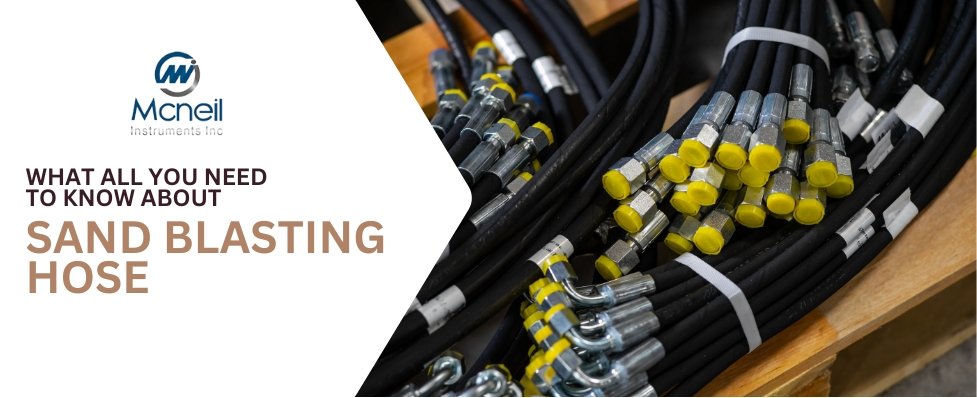Sand blasting hose is a type of hose used in the process of sandblasting. Sandblasting is a method of cleaning or preparing surfaces by propelling fine bits of material at high speeds to remove rust, paint, or other contaminants. The hose is a crucial part of the sandblasting setup, as it delivers the abrasive material from the sandblaster to the surface being treated.
Key Features of Sand Blasting Hose
- Abrasion Resistance: Sand blasting hoses are made from tough materials that can withstand the abrasive action of the sand or other blasting media passing through them. This prevents the hose from wearing out quickly and ensures its longevity.
- Flexibility: The hose needs to be flexible to allow for easy maneuverability during the sandblasting process. This flexibility enables operators to reach different angles and positions without difficulty.
- Pressure Rating: Sand blasting hoses are designed to handle high-pressure applications to ensure the efficient delivery of abrasive materials. They typically have a specific pressure rating to indicate the maximum pressure they can withstand safely.
- Size and Length: These hoses come in various sizes and lengths to accommodate different sandblasting setups and requirements. Choosing the right size and length is important to ensure optimal performance and efficiency.
Maintenance and Care of Sand Blasting Hose
Proper maintenance of sand blasting hoses is essential to ensure their durability and safe operation. Here are some tips:
- Regular Inspection: Inspect the hose regularly for any signs of wear, damage, or leaks. Replace damaged hoses immediately to prevent accidents or decreased performance.
- Cleaning: After each use, flush the hose with clean water to remove any abrasive particles or debris that may have accumulated inside. This helps prevent clogging and extends the life of the hose.
- Storage: Store the hose in a clean, dry area away from direct sunlight and extreme temperatures. Avoid kinks or bends that could weaken the hose over time.
Sand Blasting Hose Safety Considerations
- Always wear appropriate personal protective equipment, including goggles, gloves, and protective clothing, when operating a sandblasting system.
- Follow all safety guidelines and procedures outlined by the equipment manufacturer and industry standards.
- Be aware of potential hazards, such as flying debris and high-pressure streams, and take necessary precautions to avoid accidents.
Sizes Available of Sand Blasting Hoses in the Market
Here’s a simplified table outlining common sizes available for sand blasting hoses:
| Size (Inner Diameter) | Length (Feet/Meters) | Common Applications |
|---|---|---|
| 3/4 inch (19 mm) | 50-100 ft (15-30 m) | Small to medium-sized sandblasting tasks, portable sandblasting units |
| 1 inch (25 mm) | 50-100 ft (15-30 m) | General-purpose sandblasting, industrial applications |
| 1-1/4 inch (32 mm) | 50-100 ft (15-30 m) | Medium to large-scale sandblasting projects, construction sites |
| 1-1/2 inch (38 mm) | 50-100 ft (15-30 m) | Heavy-duty sandblasting, shipyards, automotive restoration |
| 2 inch (50 mm) | 50-100 ft (15-30 m) | Industrial-grade sandblasting, large surface preparation |
These sizes and lengths are typical options available in the market, but variations may exist depending on the manufacturer and specific requirements of the user. Always consult with the supplier or manufacturer to ensure you select the most suitable hose size and length for your sandblasting needs.
Construction of Sand Basting Hoses
Inner tube: The inner tube of the hose is made from a black-colored blend of synthetic and natural rubber that is highly resistant to abrasion.
Reinforcement: The hose is reinforced with plies of synthetic textile cords along with two cross antistatic copper wires. This reinforcement provides strength and stability to the hose during use.
Cover: The cover of the hose is also black in color and made from synthetic rubber. It is resistant to ozone, weather, and abrasion, ensuring durability even in harsh conditions.
Application: This hose is specifically designed for heavy-duty use in sand blasting, metal grits, and foundry waste applications. It features a conductive rubber compound to dissipate static electricity and meets abrasion loss standards according to ISO 4649 (50+5mm³).
Cover Options:
- PH674-PH1: Premium abrasion resistance
| Item Code | Dash Size | |||||||||
| inch | mm | inch | mm | psi | bar | psi | bar | kg/m | ||
| PH624-08 | -08 | 1/2 | 12.7 | 1.06 | 27.0 | 175 | 12 | 525 | 36 | 0.61 |
| PH624-12 | -12 | 3/4 | 19.0 | 1.34 | 34.0 | 175 | 12 | 525 | 36 | 0.80 |
| PH624-16 | -16 | 1 | 25.0 | 1.57 | 40.0 | 175 | 12 | 525 | 36 | 0.97 |
| PH624-20 | -20 | 1.1/4 | 32.0 | 1.89 | 48.0 | 175 | 12 | 525 | 36 | 1.32 |
| PH624-24 | -24 | 1.1/2 | 38.0 | 2.13 | 54.0 | 175 | 12 | 525 | 36 | 1.45 |
| PH624-32 | -32 | 2 | 51.0 | 2.87 | 73.0 | 175 | 12 | 525 | 36 | 2.20 |
| PH624-40 | -40 | 2.1/2 | 64.0 | 3.35 | 85.0 | 175 | 12 | 525 | 36 | 3.26 |
| PH624-48 | -48 | 3 | 76.0 | 3.94 | 100.0 | 175 | 12 | 525 | 36 | 3.90 |
| PH624-64 | -64 | 4 | 102.0 | 4.96 | 126.0 | 175 | 12 | 525 | 36 | 4.40 |
Temperature Range: The hose can be used continuously in temperatures ranging from -30°C to +70°C, making it suitable for various environments and weather conditions.
Sand blasting hoses play a vital role in the sandblasting process, delivering abrasive materials to the surface being treated safely and efficiently. By understanding their key features, proper maintenance, and safety considerations, users can ensure optimal performance and prolong the lifespan of their equipment.





